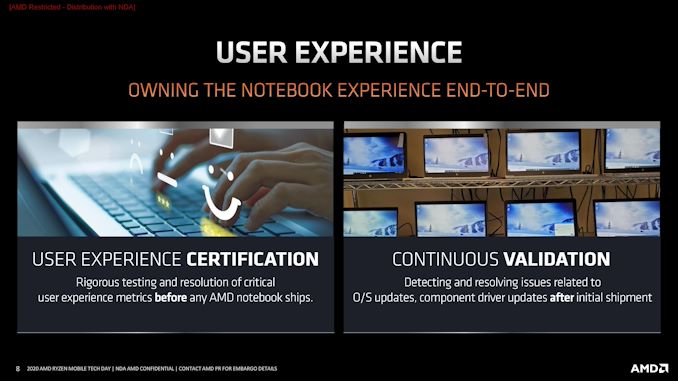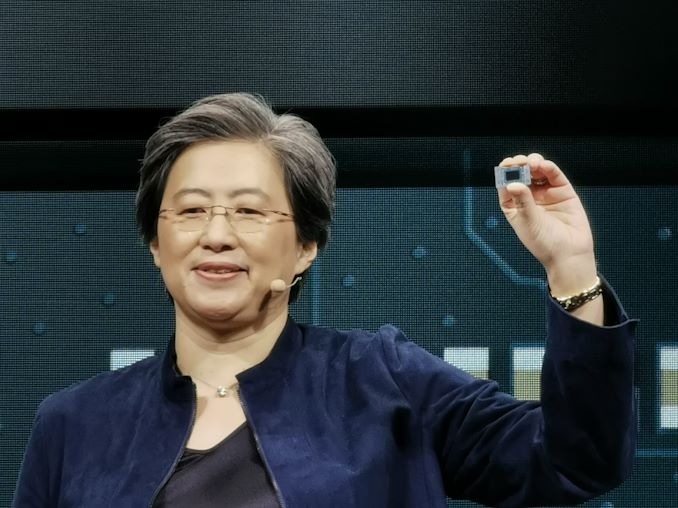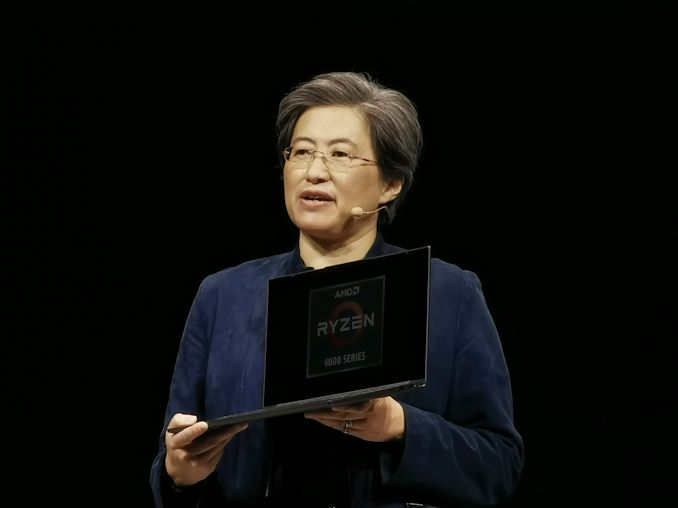AMD Details Renoir: The Ryzen Mobile 4000 Series 7nm APU Uncovered
by Dr. Ian Cutress on March 16, 2020 11:00 AM ESTThe Special HS Processors
As mentioned, at the top end of the new Ryzen Mobile 4000 list are the HS processors, offering almost exactly the same specification as the 45 W H-series processors, but at 35 W. AMD has marked these as special processors, not available to every OEM, because they fall under AMD’s new cooperative design and continuous validation programs.
In order to be able to use a HS processor, an OEM must work with AMD on the design. This is similar to what Intel does – ensure that the OEM partner gets the best from the hardware, and try and assist as to what design decisions the hardware was built for. Ultimately the product that comes out should be one that shows off the best of the hardware and gives the best user experience. On top of this, AMD has a list of ‘assured components’, validated to work against the new processors, and has created two continuous validation labs.
These labs, one in Austin and one in Shanghai, take the systems and pre-test all the new drivers and vendor software on them before they are released to the public. This is to ensure that the system is in no way compromised in performance, power, or thermals as a result of the update (to ensure that a company doesn’t completely mess with the power profile after it launches through a BIOS update or similar). AMD didn’t state how long its continuous validation program will run after the product is shipped, though I should think that at least 12-18 months should be plausible.
If the OEM does all this, and AMD agrees, then the product can use one of the HS processors.
(Note, the normal 45 W processors can be run in a 35 W mode, but just doing that doesn’t mean you can call it a HS. No doubt some third-tier OEM might try…)
The first HS-class system on the market will be the ASUS Zephyrus G14, and we learned in January that ASUS’s design has an exclusive for six months from launch. We’re expecting the G14 to hit the market in Q2, even with the current state of production, so we’ll see more HS models later in the year.
Conclusions
Ultimately today was the day that AMD was going to lift the embargo on Ryzen Mobile 4000 reviews, with the systems that AMD and its partners have provided. Due to the current ongoing issues around the world, those technical reviews of the systems will have to wait a few weeks while production is being ironed out. But for now we have a good grasp as to what AMD has pushing into the new processors coming out later this year.
Regular readers of AnandTech may remember back in 2016 I wrote a very long piece about AMD’s laptop strategy, where I tested five laptops from OEMs that were using AMD’s latest Carrizo APU at the time. The conclusions to that review were three fold: AMD was shooting itself in the foot by providing a platform that allowed its partners to be cheap; the OEM partners were being cheap by giving the hardware 13x7 screens, poor storage, poor trackpads and such because that’s all the customers seemed to want; and the customers were continually asking for cheaper systems, then getting frustrated with the poor user experience, ultimately blaming AMD rather than the OEM. It was a vicious cycle that required someone to break it.
Normally for these launches, a company will create a reference design for its partners to work with. AMD for years was creating these dull $500-$700 reference designs, which ultimately led to the paragraph above. We pled for generations for AMD to make a halo reference design, something ultraportable for $1500. For Renoir, given the reasonable performance uplift from the previous generation, the company worked with partners to create a range of high profile devices. I’ve covered a few of them in this article – the Lenovo Yoga Slim 7, the Dell G15 SE, and the ASUS Zephyrus G14 all attack different markets in very different ways, but all are examples of high-end products and design wins that AMD has needed in this market.
One of AMD’s big targets here is commercial. Despite the poor consumer performance of its older generations of laptops, the commercial laptop arm of AMD did reasonably well by comparison. AMD has announced its Ryzen Mobile 4000 Pro designs that afford admin control and sustainability over the lifetime of the product, and the key win here is that we’re seeing the processors in Lenovo’s Thinkpads, a key market.
The other big market is gaming. AMD can attack this on two fronts - the ultraportable market with the improved integrated graphics should get some good perfomrance, but also the more power hungry gaming market will get access to features like SmartShift to help balance the power between the APU and discrete GPU. AMD is also playing in the middle market here, with devices like the ASUS Zephyrus G14 with a HS processor and a Radeon RX5600M inside a 14-inch chassis, which AMD claims is the first 14-inch device with a H-class CPU and a discrete GPU inside. AMD's gaming team seem to be very happy with this design.
However, announcing systems is one thing. Deploying them is another. AMD has made a lot of claims about its Ryzen Mobile 4000 platform – performance, power consumption, and battery life. We’ve gone into detail into a lot of these, but we’re still missing one piece of the puzzle – the on-hand data. We’re hoping to get a system or two here in due course, and compare it against the competition.














95 Comments
View All Comments
eek2121 - Monday, March 16, 2020 - link
This is an intriguing part. I am hoping for laptop designs with a 4800U and 5600M, but also desktop APUs. Hopefully AMD can bring some of the nee stuff forward to desktop Zen 3 as well.heffeque - Monday, March 16, 2020 - link
It would be interesting to see these in fan and fanless AMD versions of Surface Pro versus fan and fanless Intel versions of Surface Pro.I'm especially interested in battery life, since AMD 3780U Surface Pro has horrible battery life compared to its Intel counter part.
The_Assimilator - Monday, March 16, 2020 - link
The fact that OEMs are willing to make custom designs for AMD is already a good sign that they're confident in the product. Lisa Su certainly has the right stuff.Khenglish - Monday, March 16, 2020 - link
I'm pretty unimpressed by the GPU vs the Vega 11 in APU desktops. The only major advantage Renoir has is higher clocks on the GPU core and higher officially supported memory speeds. They likely got the 56% performance per core improvement by comparing to a Zen+ with Vega 11, which will be severely clocked constrained on 12nm with a bigger core, where Renoir gets an even higher clock advantage not just from the nominal clock, but also from Picasso APUs hitting their TDP limit hard in a 25W or 35W environment.On desktop with much higher TDPs I expect Renoir to slightly beat the 3400g at stock clocks, but lose when comparing overclocked results. Picasso easily overclocks up to 1700-1800 MHz from the measly 1240 MHz stock clock. I would guess Renoir would hit around 2000, not enough to compensate for the smaller core.
eek2121 - Tuesday, March 17, 2020 - link
There are a lot of problems with your comment, but let’s start with the obvious: The TDP of the part you mentioned is at least triple that of the 4800U. Depending on how the chip is configured it is quadruple.These are laptop parts, we haven’t seen desktop APUs. AMD could add 3X as many Vega cores and still hit a 45-65 watt TDP or they can go aggressive on the CPU clocks like they did the 4900H.
Spunjji - Tuesday, March 17, 2020 - link
I'm pretty sure the desktop APU won't have more Vega CUs.tygrus - Tuesday, March 17, 2020 - link
These days doubling the GPU cores/units and running half the speed is more energy efficient. Uses more die space but I don't understand the focus on GPU MHz over energy efficiency.Spunjji - Tuesday, March 17, 2020 - link
1) Not sure evidence I've seen bears out that a 1700-1800Mhz GPU overclock is "easy". That sounds like the higher end of what you can expect. Would welcome evidence to the contrary, as I'm still considering picking one up.2) RAM speed is the big difference here. The desktop APU should get much higher memory speeds than the 3400G due to the improved Zen 2 memory controller, which ought to relieve a significant bottleneck. GPU core overclocks weren't actually the best route to wringing performance out of the 3400G.
Fataliity - Monday, March 16, 2020 - link
@Ian Cuttress, did they say what version of N7 they used for this? The density looks like either a HPC + variant, or a N7 mobile variant from what I can tell?Thank you!
abufrejoval - Monday, March 16, 2020 - link
What I want is choice. And flexibility to enable it.15 Watt TDP typically isn’t a hard limit nor is 35 or 45 Watt for that matter: It’s mostly about what can be *sustained* for more than a second or two. Vendors have allowed bursting at twice or more TDP because that’s what often defines ‘user experience’ and sells like hotcakes on mobile i7’s.
We all know the silicon is the same. Yes, there be binning but a 15 Watt part sure won’t die at 35, 45 or even 65 or 95 Watts for that matter: It will just need more juice and cooling. And of course, a design for comfortable cooling of 15 Watts won’t take 25 or 35 Watts without a bit of ‘screaming’.
But why not give a choice, when noise matters less than a deadline and you don’t want to buy a distinct machine for a temporary project?
I admit to have run machine-learning on Nvidia equipped 15.4” slim-line notebooks for days if not weeks, and having to hide them in a closet, because nobody in the office could tolerate the noise they produced at >100 Watts of CPU and GPU power consumption: That’s fine, really, when you can choose what to do where and when.
Renoir has a huge range of load vs. power consumption: Please, please, PLEASE ensure that in all form factors users can make a choice of power consumption vs. battery life or cooling by setting max and sustained Wattage preferably at run-time and not hard-wiring this into distinct SKUs. I’d want a 15 Watt ultrabook to sustain a 35 Watt workload screaming its head off, just like I’d like a 90 Watt desktop or a 60 Watt NUC to calm down to 45/35/25 Watt sustained for night-long batches in the living room or bed-side—if that’s what suits my needs: It’s not a matter of technology, just a matter of ‘product placement’.